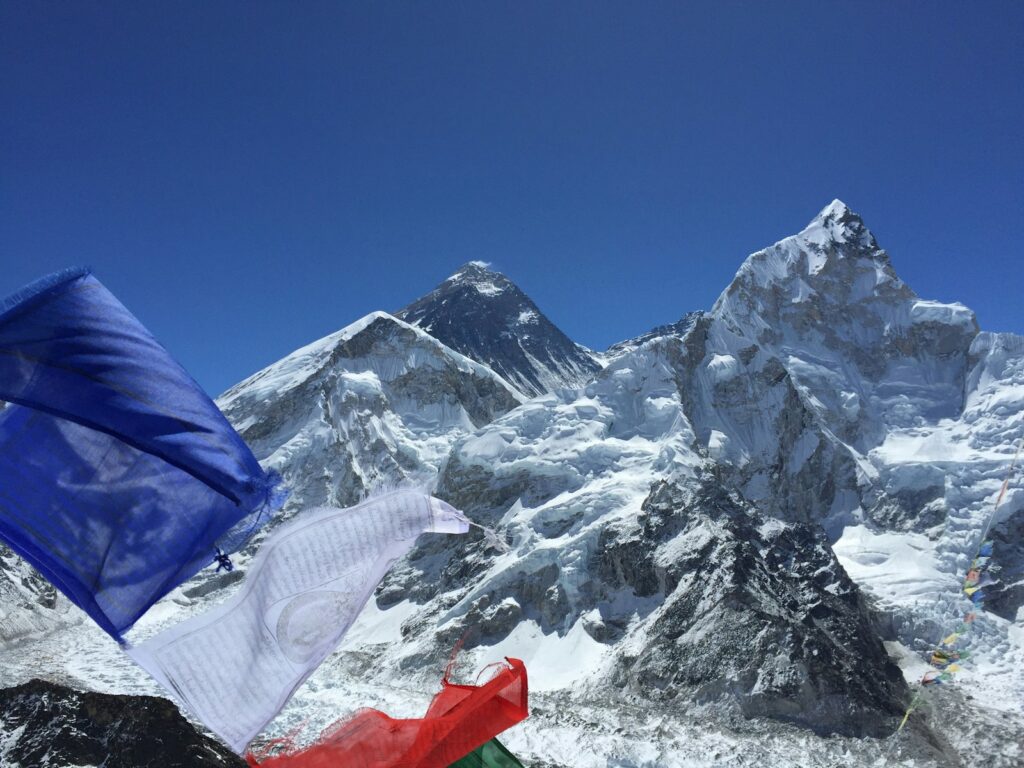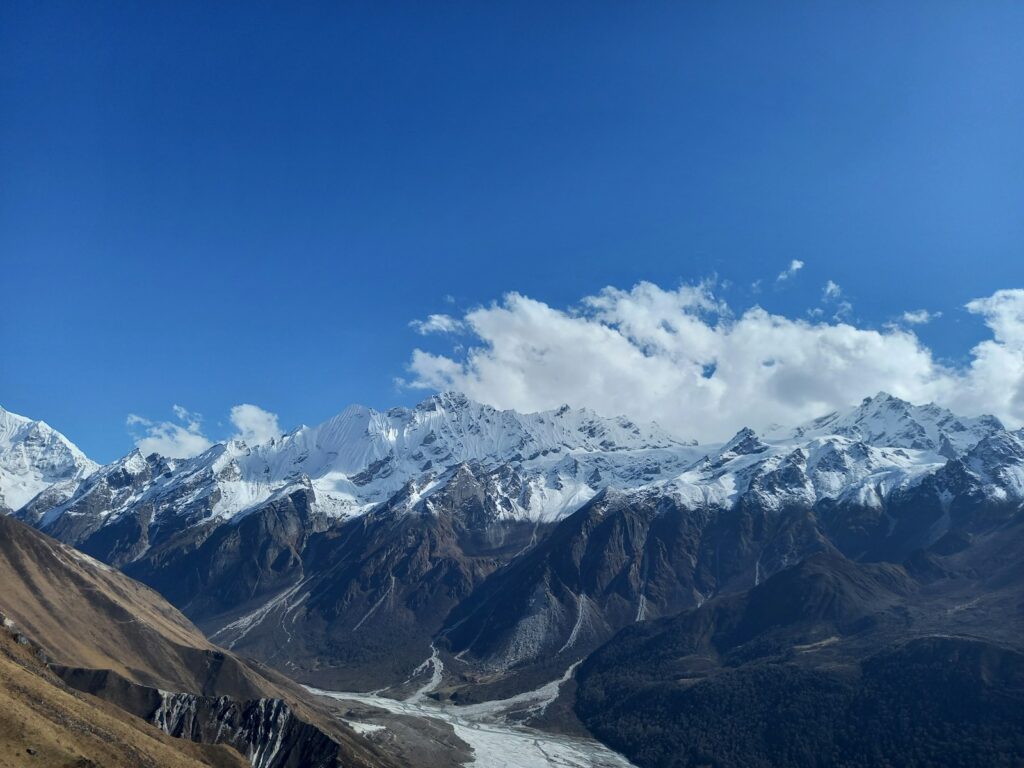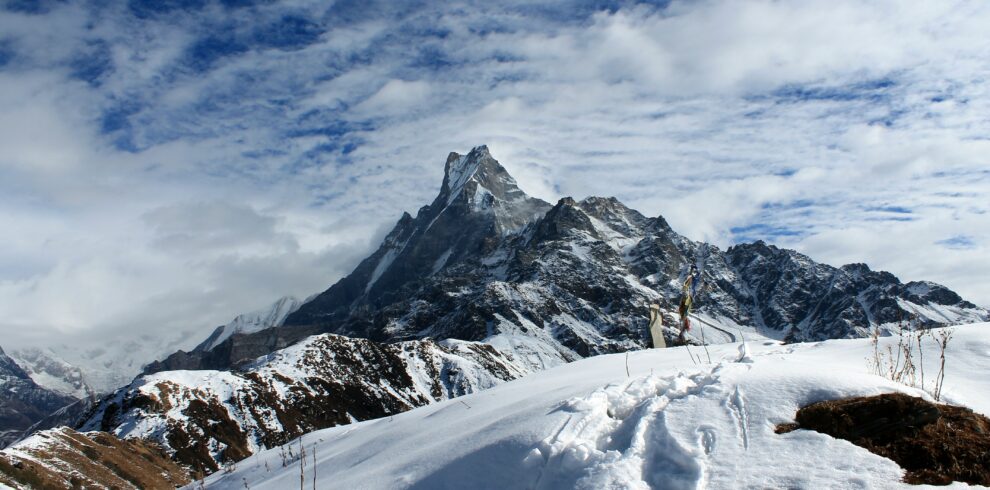Trip Info
-
Nepal
-
Everest Region
-
Trekking
-
17 Days
-
Spring - Autumn
-
Difficult
-
5545 Meters
-
1 - 32 People
-
30 Days Before Start
Overview
Everest High Passes Trek is an exhilarating adventure in the Himalayas of Nepal that includes trekking on popular Everest trails while also discovering unique gems of the Khumbu region. On our trekking adventure, we cross three high passes in the Everest region – Kongma La Pass (5,535/18,159ft), Cho La Pass (5420m/17,782ft) and Renjo La Pass (5,340m/17,520ft) and set foot on the Everest base camp, climb Kala Patthar and Gokyo Ri; and tour Gokyo Lakes. This route also introduces trekkers to the remote and untouched Nangpa La Valley, the Sherpa village of Marlung and the monastery village of Thame.
Trip Highlights
- Cross the popular three high passes of the Khumbu region
- Take delight in the panoramic views of Everest from Kala Patthar vantage point
- Cross the Gokyo Ri and savor the tranquil Gokyo lakes
- Experience breathtaking flights to and from Lukla
Itinerary
Transfer to domestic airport and 30-minutes flight to Lukla. The trek begins gently up by the river side, along excellent paved footpaths, passing a multitude of teahouses and scattered green conifers. Phakding at 2,610 m, is a pretty village comprising approximately 35 houses. It is roughly a 3/4-hour walk from Lukla and is located at both sides of Dudh Koshi River. Overnight at guesthouse.
The day will begin with breakfast and walk to Monjo, another beautiful Sherpa settlement of the trek; official entry into the Sagarmatha National Park where you will have to show your permits, at the check point in Monjo.The walk to Namche Bazaar involves a tough uphill climb of about 590m, taking approximately 5/6-hours,As gateway to the Khumbu region, Namche Bazaar, at an altitude of 3440meters, is famous for its many bakeries and local market which takes place each Saturday. Built on a steep mountain bowl with excellent views of high Himalaya on the side, the town has restaurants, shops, banks and currency exchange. There are also availability of cyber cafes and pool halls. Overnight at guesthouse.
It is important to walk to higher altitudes while you stay two days in Namche bazaar. There are options here either to trek to Khumjung where you can visit the local area and to Thame village of Sherpa Everest expediters and syangboche, above the airstrip is the Everest view hotel, which was set up by the Japanese to bring affluent tourists into the region for a prime view of Everest. The scheme was brought down by the fact that the hotel was at nearly 4000m and many suffer from altitude sickness. Overnight at guesthouse.
The trek from Namche Bazaar (3,440m) to Tengboche (3,867m) is a scenic and spiritually uplifting journey through the heart of the Khumbu region. The trail begins with a gentle climb out of Namche, offering stunning views of Ama Dablam, Everest, Lhotse, and other Himalayan giants. After an initial descent to the Dudh Koshi River at Phunki Tenga, the path ascends through fragrant pine and rhododendron forests to the famous Tengboche Monastery—the largest in the Everest region.
The journey will pass through wooded forests and along the Imja Khola valley. The views will become more impressive as the high Himalayas begin to surround you. You will contour gradually to Pangboche, an interesting gompa site above the main village, this is the oldest monastery in the region and apparently dates from the introduction of Buddhism to Khumbu. You will then climb up to Dingboche at 4360meters. The views of Amadablam and Island Peak are breathtaking.
Today, we will have another day for acclimatization. You will head to another beautiful part of the Khumbu region, which offers you a magnificent view of the Mt. Makalu, Island Peak, Peak etc. We will hike to Nakarkhang Peak for acclimatization hike.
The trek from Dingboche (4,410m) to Chhukung (4,730m) is a short but rewarding hike deeper into the Imja Valley, offering spectacular views of some of the region’s highest peaks. The trail gradually ascends along alpine meadows and glacial moraines, with stunning panoramas of Lhotse, Ama Dablam, Island Peak, and the massive south face of Nuptse.
The trek from Chhukung to Lobuche (4,940m) via Kongma La Pass (5,535m) is one of the most challenging and adventurous sections of the Everest Three Passes Trek. The day begins early with a steep ascent from Chhukung, crossing rocky terrain and glacial moraines to reach the top of Kongma La, the highest and most demanding of the three passes. From the summit, you’ll be rewarded with breathtaking views of Makalu, Lhotse, Nuptse, and the Khumbu Glacier far below.
The trail follows western side of khumbu valley ascends gently through meadows nearby the glacial moraine after that ascends and descends in the rocky path with some rounding the bands. Along the way you can enjoy incredible views of Pumori (7167m) Lingtren (6713m), Khumbutse (6639m), Nuptse (7879m), Lobuche east (6090m) as well as Khumbu glacier and icefall. After finishing several bands you will a bit descends to Gorak Shep (5140m). After reaching Gorak Shep you may have your lunch and leave your bag pack at teahouse then start your journey to Everest base camp (5364m). You will spend about 4 hours trek up to Everest Base Camp and back to Gorak shep. The trek trail is on glacier and snow capped rocks. You can also see many small frozen lakes around the Everest Base Camp. There are several mountains including Pumori (7165m), Khumbutse (6639m), Nuptse (7879m) and Lhotse (8516m). The most impressive view from Everest base camp is the Khumbu icefall. After enjoying beautiful moment at the Everest base camp then return back to Gorak Shep. Overnight at guesthouse.
An early morning hike from Gorak Shep (5,164m) to Kala Patthar (5,545m) is a highlight of the Everest region, offering the best panoramic views of Mount Everest, along with Nuptse, Pumori, Lhotse, and the Khumbu Glacier. The steep ascent takes about 2 to 3 hours, and reaching the summit just before sunrise rewards trekkers with an unforgettable Himalayan spectacle as the peaks glow with golden light.
After enjoying the views and capturing photos at Kala Patthar, you’ll descend back to Gorak Shep for breakfast. From there, the trek continues downhill along the main Everest Base Camp trail to Lobuche (4,940m), a relatively moderate walk of about 2 to 3 hours. The full day is physically demanding due to the altitude and elevation changes, but it’s also deeply rewarding, combining one of the best viewpoints in Nepal with a gradual return to lower elevations.
The trek from Lobuche to Dzongla (4,830m) is a short yet scenic journey, taking about 3 to 4 hours as you leave the main Everest Base Camp trail and head toward the quieter, more rugged terrain of the Cho La Pass route. The trail offers stunning views of Cholatse, Ama Dablam, and glacial landscapes, with gentle ascents and descents along the way. As you approach Dzongla, the scenery becomes increasingly dramatic, with turquoise glacial lakes and towering peaks surrounding the small, peaceful settlement. Dzongla serves as a strategic and tranquil stop to rest and acclimatize before tackling the challenging Cho La Pass the following day.
The trek from Dzongla to Gokyo via the challenging Cho La Pass (5,420m) is a strenuous yet incredibly rewarding journey, taking about 8 to 9 hours. The day starts early with a steep, rocky climb to the pass, often requiring careful footing across icy or snowy sections and a short glacier crossing near the summit. From the top, you’re treated to stunning views of Cholatse, Lobuche East, and the surrounding peaks. The descent is steep and can be slippery, leading to the small settlement of Thagnak, after which the trail continues across glacial moraines and rugged terrain before opening up to the breathtaking Gokyo Valley, with its serene turquoise lakes and towering Himalayan giants like Cho Oyu.
Today is a well-earned rest and acclimatization day in Gokyo, one of the most stunning locations in the Everest region. In the morning, you can opt for a hike up Gokyo Ri (5,357m), a steep but rewarding climb that takes about 2 to 3 hours. From the summit, you’ll witness one of the most spectacular panoramic views in the Himalayas, featuring Mount Everest, Lhotse, Makalu, Cho Oyu, and the shimmering Gokyo Lakes below. After the descent, the rest of the day can be spent relaxing by the lakeside, exploring the village, or simply soaking in the incredible alpine scenery and thin mountain air.
The trek from Gokyo (4,790m) to Marlung (4,210m) via Renjo La Pass (5,360m) is a challenging yet awe-inspiring journey that takes about 7 to 8 hours. The day begins with an early start and a steep ascent to the top of Renjo La, one of the most scenic passes in the Everest region. From the summit, you’ll be rewarded with breathtaking views of Everest, Lhotse, Makalu, and the Gokyo Lakes spread out below. The descent is steep and follows a zigzag trail down to the remote Lungden Valley, eventually reaching the quiet village of Marlung. This route offers a peaceful escape from the busier trails and a unique perspective on the rugged beauty of the Khumbu region.
The trek from Marlung (4,210m) to Namche Bazaar (3,440m) takes around 5 to 6 hours and follows a scenic downhill route through the tranquil Bhote Koshi Valley. The trail passes through traditional Sherpa villages like Thame, known for its ancient monastery and as the hometown of several famous mountaineers, including Tenzing Norgay. As you descend, the landscape gradually shifts from alpine to more forested terrain, and the warmer, thicker air at lower elevations brings welcome relief. Reaching Namche feels like returning to civilization, with its lively atmosphere, cozy teahouses, and stunning views of the surrounding peaks.
The trek from Namche Bazaar (3,440m) to Lukla (2,860m) is the final leg of your Everest region adventure, taking about 6 to 8 hours of steady downhill walking. The trail descends steeply at first, crossing several suspension bridges over the Dudh Koshi River, and passes through charming villages like Monjo, Phakding, and Chheplung. While the route is mostly downhill, a few short uphill sections and rocky paths keep the day engaging. Arriving in Lukla marks the end of your trek, where you can celebrate your journey, enjoy a hot meal, and rest before flying back to Kathmandu the next day.
In the morning, we take the tiny aircraft to flight from Lukla to Kathmandu which is very interesting scenery flight journey on the earth. After arrival in Kathmandu airport we drive you to your hotel.
Includes
Cost Includes
- Three meals a day (Breakfast, Lunch, Dinner) whilst on trekking.
- Cozy guesthouse accommodation whilst on trekking as per the itinerary.
- Domestic flight Kathmandu - Lukla - Kathmandu for guest and guide inclusive with all taxes.
- All necessary government and local permits, National Park entry fees.
- TIMS registration card
- An experienced fluent English speaking guide, licensed by ministry of Culture, Tourism Civil Aviation.
- Guide food, accommodation, clothing, salary & insurance.
- Nepal Holiday sleeping bag,down jacket, duffel bag and area trekking map.
- Airport transfers during the whole trip as per the itinerary.
- First aid medical kit with Oxymeter to check pulse,heart rate and oxygen saturation at higher altitude.
- All applicable taxes as per the government rules and regulations.
- Farewell dinner in Kathmandu at typical Nepali restaurant.
- Pre-trip meeting in Kathmandu before the trek.
Cost Excludes
- International Airfare, visa fees and re-entry visa fees if applicable
- Meals at Kathmandu except mentioned.
- Hotel Accommodation in Kathmandu.
- Personal nature expenses like bar bills, beverage bills, hot drinks, telephone bills, laundry etc.
- Porters to carry your luggage (you can add a porter when booking)
- Your Travel Insurance and rescue evacuation, medical costs.
- Gratitude (tip) for staff.
FAQs
Yes, most treks in Nepal require one or more permits. The most common are the TIMS (Trekkers’ Information Management System) card and area-specific permits like the Annapurna Conservation Area Permit (ACAP) or Sagarmatha National Park Permit. Restricted areas such as Upper Mustang or Manaslu require special permits and must be arranged through registered trekking agencies. Carrying the correct permits is essential, as checkpoints are common along trails.
The ideal trekking seasons are spring (March to May) and autumn (September to November). These months offer clear skies, mild temperatures, and breathtaking mountain views. Spring is known for blooming rhododendrons, while autumn offers the best overall weather conditions. Monsoon (June to August) brings heavy rains, and winter (December to February) can be extremely cold and snowy at higher altitudes.
Fitness requirements vary depending on the trek, but a good baseline of cardiovascular health and endurance is helpful. Treks range from easy, low-altitude hikes like Ghorepani Poon Hill, to challenging high-altitude circuits like Everest Base Camp or Manaslu Circuit. Regular walking, stair climbing, or hiking in advance can prepare you well. Mental stamina is equally important, especially on longer or more remote trails.
Yes, altitude sickness, or Acute Mountain Sickness (AMS), can affect anyone above 2,500 meters, regardless of fitness or experience. Common symptoms include headache, nausea, dizziness, and shortness of breath. To reduce the risk, it’s essential to acclimatize properly, ascend gradually, stay hydrated, and avoid alcohol. In serious cases, descending is the only effective treatment, and travel insurance should cover emergency evacuation if needed.
Independent trekking is allowed in many areas like Annapurna, Everest, and Langtang. However, restricted areas such as Upper Mustang, Manaslu, and Dolpo require you to trek with a registered guide and at least two trekkers. Even where not mandatory, many trekkers choose to hire a guide for navigation and cultural insight or a porter to reduce physical strain. Going with a guide also adds a layer of safety and local support.
Most popular treks in Nepal offer teahouse accommodation, which are small lodges run by local families. These lodges typically provide basic rooms with shared bathrooms, local meals like dal bhat, and sometimes limited electricity or Wi-Fi. In more remote or less-developed areas, accommodation may be more rustic or require camping arrangements. It’s advisable to carry a sleeping bag for warmth and hygiene, especially in higher elevations.
Packing smart is key, as you’ll want to balance essentials with minimal weight. Core items include layers of clothing, a warm down jacket, sturdy trekking boots, a sleeping bag, headlamp, and first-aid kit. Don’t forget water purification tablets, snacks, sunscreen, and trekking poles if needed. Depending on the route and altitude, gear requirements may vary, and renting equipment in Kathmandu or Pokhara is also an option.
Yes, travel insurance is strongly recommended for all trekkers in Nepal. Your policy should specifically cover trekking at high altitudes (up to 6,000 meters or more) and include emergency helicopter evacuation. Medical care in remote areas is limited, and evacuation can be very expensive without insurance. It’s also helpful if your insurance covers trip cancellations, lost luggage, and other travel mishaps.
In more developed trekking regions like Everest and Annapurna, some villages have ATMs and paid Wi-Fi, but these services can be unreliable. In remote areas, there may be no access to banks or internet, so it’s best to carry enough cash (Nepali rupees) for your entire trek. Lodges often charge extra for device charging or internet usage. Trekking unplugged can be part of the adventure, so plan accordingly.
Yes, Nepal is generally considered a safe destination for solo female travelers, especially on well-trodden routes. Many women trek alone every year without issues, but taking basic precautions, such as informing someone of your plans and staying in reputable lodges, is wise. Hiring a female guide or joining a group can enhance safety and add cultural depth. Nepalese people are friendly and hospitable, but like anywhere, it’s important to stay aware of your surroundings.









